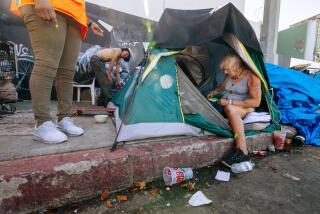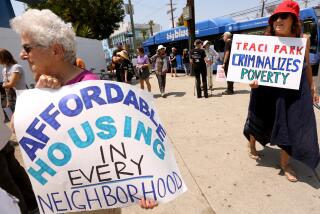Pols walk around without a plan
- Share via
Mayor Antonio Villaraigosa is at his cocky best, grinning from a stage toward a Saturday crowd of maybe 4,000, declaring into a microphone that he’s been challenged by an unnamed member of the Los Angeles County Board of Supervisors to race this morning’s 5K to end homelessness instead of just walking the distance around Exposition Park like everyone else.
“I was prepared to run him into the ground!” Villaraigosa shouts to the cheering crowd. “But unfortunately, he didn’t show up.”
So here it is: as apt a symbol as any for the fractious and fractured official response to homelessness, one of the Los Angeles region’s most public and humiliating failures. Today, the city is here, but the county didn’t show up.
City Hall has a plan to fix homelessness. The LAPD has a plan. The county has a plan. The agency that coordinates the city and the county’s response to homelessness has a plan. But it never seems like they’re all the same plan. And they can’t seem to get their act together enough to come up with what some of them, but not all of them, claim is the key step in solving the problem: a plan a a 10-year action plan similar to the proposals other cities have used to plot their strategies for housing their homeless.
Los Angeles notoriously is the capital of American homelessness, with perhaps 73,000 people the number is a mere stab in the dark in the county going to sleep on any given night on the street, under an overpass, in a car or in a temporary shelter. The population is diverse. Banners posted on the route of this fundraising walk offer depressing stories and statistics: 10,000 military veterans. 17,000 women. 11,000 children. The addicted, the evicted, the mentally ill.
Of the Los Angeles Unified School District’s 170,000 students, 13,521 are homeless, according to the United Way.
Dealing with the problem requires a type of coordination that makes one question the sanity of California’s political shapers of decades past. The county has the service programs the mental health treatment, the drug treatment. County personnel are ready to dispense the assistance to their clients, but there’s little point offering treatment if the ill are simply sent back to the street. Cities have the money for housing. So the county and the cities squabble over who spends first, and where to build permanent supportive housing. Finger-pointing. Paralysis.
The problem is exacerbated by the existence of skid row, once an unnoticed section of downtown Los Angeles where competing cross-country rail lines ended and travelers looking for work joined hobos and winos in the nearby flophouses and, eventually, streets. It seemed sensible at the time for government and nonprofit service providers to set up shop here, creating a sort of containment zone where jails and prisons would drop their released inmates, hospitals would discharge their homeless patients and, frankly, other neighborhoods and cities would dump their problems far from the sight of the average L.A. resident.
But downtown Los Angeles is now a trendy spot for upscale housing and for business, leading officials to step up efforts to “clean up skid row.”
There lies yet another disagreement. If the goal is to clean up skid row, then there is obvious merit to the Safer Cities Initiative under which Police Chief William Bratton has led a crackdown on drug dealing and other crimes in the area. Skid row is being cleaned up. But that’s not the same as helping the homeless, and certainly not the same as ending homelessness.
Observers fault or credit various programs based on how they define the problem and how they define their own politics. At Saturday’s 5K, some of the thousands of can-do optimists who show up to walk mutter about Safer Cities and the recent City Journal article by Heather Mac Donald (find a shorter version in Sunday’s Los Angeles Times ) praising the initiative and blasting the “homeless industry” that provides services and advocates for the street people in the area. Some, though not all, praise the October report by UCLA professor Gary Blasi that criticizes Safer Cities and its focus on arrests.
The idea may be sound you arrest the homeless lawbreaker for a quality-of-life crime, you send him to a judge who refers him to county health services and city housing, he gets his record cleared up, he starts getting his Social Security check and he’s off the street for good.
But city officials know there is little permanent supportive housing city housing paired with county services and that jail will be the result of most skid row tickets for jaywalking and similar infractions, according to a lawsuit targeting the crackdown. The Los Angeles Daily Journal (subscription only) reported Wednesday that civil rights lawyers filed a complaint against Safer Cities, alleging that police are “harassing and intimidating black males” in the area. The suit is based in part on Blasi’s research, which the professor said shows that people are being cited and jailed because they are poor.
So the recent settlement of a lawsuit over the city’s ordinance against sleeping on sidewalks, pitting the city against the ACLU of Southern California, did not end the political and philosophical debate at all.
It’s one thing for people of goodwill to want to take the next step in the fight to end homelessness in Los Angeles. It’s another thing to know what that step is. It seems we can’t agree on how to define the problem, leaving us miles away from arriving at a solution.
So is it an act of faith or an act of frustration that draws thousands of people to Exposition Park for the United Way’s HomeWalk? Will the thousands assembled here even walk their 5 kilometers in the same direction?
In fact, they do. Around the Coliseum, through Exposition Park’s Rose Garden, into the USC campus, back through the roses and to the Coliseum again. It’s one big rally, with the walkers many of whom work for service providers or governmental agencies chatting cheerfully about the progress they have made over the last three years. Steps invisible to those outside of government, like a new memorandum of understanding or an accord among key officials, are hailed by insiders as though they are milestones.
And they may well be. The optimism is exhilarating. Villaraigosa sets the pace, then drops back into the crowd to chat amiably with walkers, and surges ahead again, talking all the time about the team he has assembled to fund supportive housing. The county is here after all, although the supervisor who challenged Villaraigosa to run is not; in his place, county chief executive Bill Fujioka strides to the front. City and county managers may grouse a bit about each other, but they also enthusiastically utter words beyond the grasp of the mere resident NOFAs, Project 50, LAHSA. Although the language is foreign, the meaning is clear. These people, at least, believe that the various programs and agencies and agendas are slowly coalescing into a single, and achievable, united program for sharply reducing homelessness in Los Angeles.
The entire walk is not so much a fund-raiser it reportedly raised a respectable half-million dollars but an exercise in civic recharging. Such things are necessary every now and then, and even worthwhile, especially if they are followed by a wider commitment, or recommitment, to action.
Robert Greene is a member of The Times’ editorial board.
Send us your thoughts at [email protected].More to Read
A cure for the common opinion
Get thought-provoking perspectives with our weekly newsletter.
You may occasionally receive promotional content from the Los Angeles Times.











